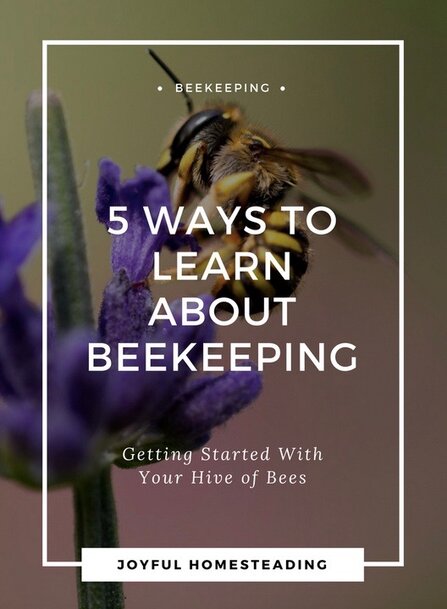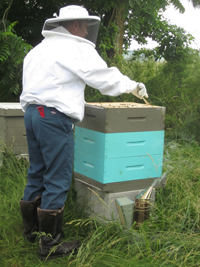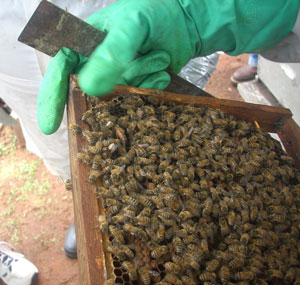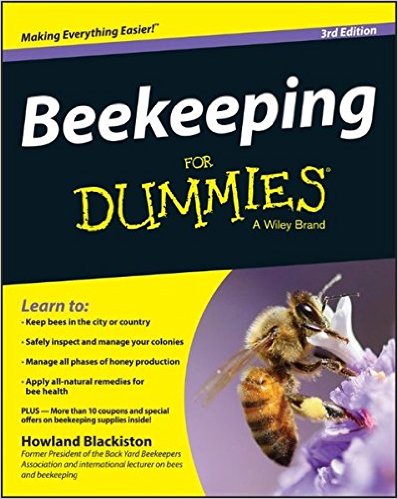Learning About Beekeeping
Learning about beekeeping and then keeping your own bee hives is a great way to increase the productivity of your garden, harvest your own honey and wax and help save these amazing insects who are responsible for much of the world's food production. Here are five ways you can learn about beekeeping.

1. Join a Beekeeping Club
There are beekeeping clubs in most major cities throughout the country. Go on a search engine and type beekeeping club along with your city. Or type the name of your state and the word beekeeping. You're bound to find a link or two leading you to a beekeepers site.
Join the club and attend the meetings regularly. Experienced beekeepers will regularly talk about beekeeping topics, and you'll learn tons.
2. Get Some Good Books on Beekeeping (And Read Them)
|
One really good resource that the beekeepers in my local club swore by is Beekeeping for Dummies by Howland Blackiston. |
There is also an idiots guide and a lot of other good resources.
Check with your local library and read as much as you can before investing in beekeeping equipment and a package of bees.
3. Take Some Beekeeping Courses
State beekeeping associations will often offer these, so ask around. Beekeeping courses are a good way to learn the ins and outs of beekeeping quickly.
4. Spend Time With Beekeepers
Once you meet a few seasoned beekeepers at your local beekeeping club, ask if you can come watch the next time they work with their bees. Some clubs also offer field days where you can come and observe and learn.
5. Dive In
 |
Of course the best way to learn is to actually start keeping bees. Like most beekeepers, you will likely make mistakes, learn from them and improve, but don't give up; beekeeping is one of the most relaxing and satisfying things you will ever do. |
The Crowning of a Queen
|
The queen is most important of all the bee colony members, for without her a hive will die within weeks. |
 |
Why? Because during the spring and summer months, the average life cycle of a bee is only a few weeks due to hardships and predators.
It is the queen's job to lay sufficient eggs to replace the up to 1,800 bees that die daily.
That's why one of the most important aspects of learning about beekeeping is learning to recognize your queen.
When a queen is too old or worse yet, there is no queen, workers will begin to produce a replacement from one of the bee colony members. They select either an egg or a very young larva and feed her royal jelly throughout her larva stage. In just a couple of weeks she is a fully developed queen, ready within days to mate.
She then leaves the colony to mate between 10 to 12 drones, all of whom will die in the process. Afterward, she returns home to lay eggs lots of them for the rest of her life to produce more bee colony members. A queen will lay anywhere from 1,500 to 2,500 eggs per day and can live up to five years. She may take small rest periods of 5 or 10 minutes, but generally she lays eggs around the clock. And you thought you had it rough!
Learning About Beekeeping
How to Recognize the Queen
The queen will be longer usually one and a half times longer and thinner than the workers. Also, her wings will be shorter. Her body will be more pale than the others, and she will have less pronounced stripes on her abdomen. Just behind her head, she will also have a bald spot. Learning about beekeeping includes remember these vital facts about your queen.
Beekeepers will often mark her with a colored dot so she can be easily recognized among the bee colony members. Being able to spot your queen easily makes learning about beekeeping much easier.
Learning About Beekeeping
The Queen's Court
When learning about beekeeping, you should also learn to recognize your worker bees. Your queen will be surrounded by workers who are known, naturally, as the royal court. Every worker takes a turn in the court. They feed her, touch her and rub their antennas over her. By doing this, they will then spread her scent throughout the hive.
Learning About Beekeeping
The Worker
Workers are the go-to ladies of the bee colony members. They are made up of female bees whose reproductive organs have not developed. They are the smallest bees in the hive and do all the work. A worker bee has pollen baskets, a honey stomach, wax glands and unfortunately for us a barbed sting. One colony can have hundreds of thousands of workers.
In the winter, a worker can live up to 140 days, but in the summer, she will live for only 15 to 48 days. If she isn't killed by predators or an accident, she will work herself to death within five weeks. In the early days of her life, she feeds the queen, stores nectar and pollen brought in by other bees and cleans the hive.
When she is three weeks old, she will begin to leave the other bee colony members and eventually fly miles each day, to collect nectar and pollen and pollinate our gardens and orchards. She will do this until she can no longer fly. Then at the ripe old age of five weeks, she will leave the hive and die.
The Drone
Male bees are the drones. They are much larger and are a bit more square-shaped than the other bee colony members. They do not have a sting, and their only job is to mate with the queen. They will live anywhere from 21 to 32 days.
In many ways, drones are the Rodney Dangerfields of the bee colony members in that they don't get much respect. In the fall, the worker bees will literally pick up the drones and toss them out of the hive. If the drones try to return, the workers will refuse to let them back in. Eventually, the drones give up and look for queens from other colonies with which to mate.











New! Comments
Have your say about what you just read! Leave me a comment in the box below.